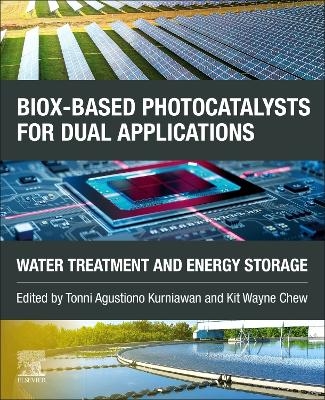
BiOX-based Photocatalysts for Dual Applications
Elsevier - Health Sciences Division (Verlag)
978-0-443-23861-1 (ISBN)
- Noch nicht erschienen (ca. Juni 2025)
- Versandkostenfrei
- Auch auf Rechnung
- Artikel merken
Written by world-class experts in their respective fields, this book will be an excellent resource for postgraduate students and postdoctoral researchers and academics in chemical engineering, chemistry, physics, and environmental science doing research on advanced oxidation process (AOP); technicians working in research and development on different uses of BiOX-based material for photocatalytic applications; and waste specialists in the waste and energy industries.
Dr. Tonni Agustiono Kurniawan’s degrees include a B.Sc. in chemistry from the Bogor Agricultural University (Indonesia), a M.Sc. in environmental technology from the Thammasat University (Thailand), and a Ph.D. in applied chemical technology from the Hong Kong Polytechnic University (China). He is the author of over 130 peer-reviewed publications in ISI-rated journals, 26 conference proceedings, including 9 book chapters and 6 monographs on waste to energy and wastewater treatment. He received the 2010 Green Talent Award from German Federal Ministry of Education and Research (BMBF), the 2013 Young Scientist Award from the World Economy Forum (WEF) (Switzerland), and the 2014 Scope-Zhongyu (France) for his outstanding research contribution to the fields of study. Elsevier and Stanford University (US) listed him among the top 2% of highly cited scientists in the field of Environmental Sciences. Dr. Kit Wayne Chew is Assistant Professor in Nanyang Technological University’s School of Chemistry, Chemical Engineering and Biotechnology. He obtained his PhD from the University of Nottingham, where he began his research in sustainable bioprocess engineering for food and pharmaceutical products. His current research examines the utilization of algae biotechnology to develop cost-effective and environmentally friendly methods for the synthesis of functional ingredients. Dr. Chew’s professional appointments include Associate Member in the Institution of Chemical Engineers Malaysia (IChemE), Graduate Engineer registered with the Board of Engineers Malaysia, and Graduate Technologist registered with the Malaysia Board of Technologies. He is listed as the #5 author contributing research on the topic of “Microalgal Technology on SciVal.
Section 1: How to synthesize BiOX (X=Cl, Br, I) photocatalysts?
1.1 Introduction of BiOX photocatalysts
1.2 Outlook of photocatalytic properties of BiOX
1.3 Controllable synthesis, growth mechanism, and application of BiOClxBr1-x
1.4 Hydrothermal synthesis of Bi5O7Br and photocatalytic activity under visible light
1.5 Synthesis of BiOCl thin film by electrochemical method for photocatalysis
1.6 Solvothermal synthesis of hierarchical Bi4O5I2
Section 2. Development strategies of self-assembling BixOyXz (X=Cl, Br, I) photocatalysts
2.1 Controllable growth and application of BiOClxBr1-x photocatalysis
2.2 Electronic structure and photocatalytic activity of BiOCl photocatalyst.
2.3 Ag-BiOBr-rGO photocatalyst for enhanced photodegradation
2.4 Fabrication of Bi24O31Br10 as a highly efficient photocatalyst
2.5 Bi7O9I3 microsheets for efficient photocatalytic degradation
2.6 BiOCl-g-C3N4 ultrathin heterostructure nanosheets
2.7 Bi3O4Cl single-crystalline nanosheets with high {001} facet
2.8 BiOCl/Bi24O31Cl10 heterojunctions via self-combustion
Section 3. Structural modification for sustainable and improved BiOX photocatalysts
3.1 BiOBr/Bi12O17Cl2 heterojunction
3.2 p-n BiOI@Bi5O7I heterojunction
3.3 Bi24O31Br10 nanosheets with controllable thickness
3.4 Intra-heterostructure BixOyClz nanophotocatalyst
3.5 Z-scheme Bi2MoO6/CdSe heterojunction
3.6 BiOI/TiO2 heterostructured nanofibers
3.7 Bi4O5Br2 photocatalyst with tunable conduction
Section 4. Moving towards BiOX-based photocatalysis for wastewater treatment
4.1 Bi12O15Cl6 photocatalyst for photodegradation of bisphenol A
4.2 Challenges and bottlenecks of BiOX in wastewater treatment
4.3 Emerging opportunities of BiOX in wastewater treatment
4.4 Ways forward for BiOX-based photocatalysts in water treatment
4.5 Feasibility of BiOX for photocatalytic degradation of organic pollutants
4.6 Applicability of BiOX for photocatalytic degradation of inorganic pollutants
4.7 State of the art of BiOX for aquatic environmental remediation
Section 5. Application of photocatalytic process for energy conversion/storage
5.1 Application of BiOX for photocatalysis production of H2
5.2 Utilization of BiOX for photocatalytic reduction of CO2
5.3 Defect engineering of BiOX- based photocatalysts for energy storage
5.4 BiOX-based 2D composites for solar energy harvesting
5.5 L-BIOX as a high-capacity anode for energy storage of Li ion batteries
5.6 Bi-based photocatalysts for energy storage applications
5.7 BiOX-based photoctalysts for water splitting
5.8 Bi4O5Br2 photocatalyst for CO2 photoreduction
5.9 Bi4O5Br2 for solar-driven conversion of CO2 into valuable fuels
5.10 State of the art of BiOX for removal of air pollutant
| Erscheint lt. Verlag | 1.6.2025 |
|---|---|
| Verlagsort | Philadelphia |
| Sprache | englisch |
| Maße | 191 x 235 mm |
| Themenwelt | Naturwissenschaften ► Chemie ► Technische Chemie |
| Technik | |
| ISBN-10 | 0-443-23861-8 / 0443238618 |
| ISBN-13 | 978-0-443-23861-1 / 9780443238611 |
| Zustand | Neuware |
| Haben Sie eine Frage zum Produkt? |
aus dem Bereich


